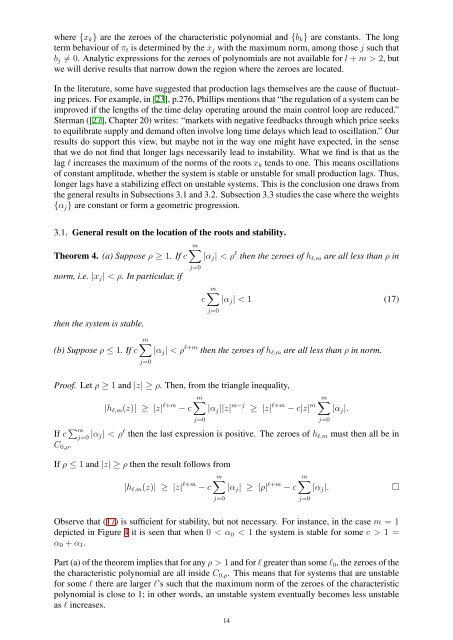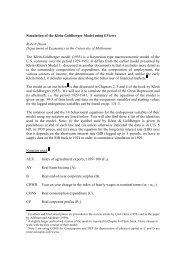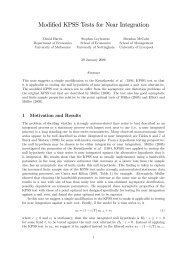Cobweb Theorems with production lags and price forecasting
Cobweb Theorems with production lags and price forecasting
Cobweb Theorems with production lags and price forecasting
You also want an ePaper? Increase the reach of your titles
YUMPU automatically turns print PDFs into web optimized ePapers that Google loves.
where {xk} are the zeroes of the characteristic polynomial <strong>and</strong> {bk} are constants. The long<br />
term behaviour of πt is determined by the xj <strong>with</strong> the maximum norm, among those j such that<br />
bj �= 0. Analytic expressions for the zeroes of polynomials are not available for l + m > 2, but<br />
we will derive results that narrow down the region where the zeroes are located.<br />
In the literature, some have suggested that <strong>production</strong> <strong>lags</strong> themselves are the cause of fluctuating<br />
<strong>price</strong>s. For example, in [23], p.276, Phillips mentions that “the regulation of a system can be<br />
improved if the lengths of the time delay operating around the main control loop are reduced.”<br />
Sterman ([27], Chapter 20) writes: “markets <strong>with</strong> negative feedbacks through which <strong>price</strong> seeks<br />
to equilibrate supply <strong>and</strong> dem<strong>and</strong> often involve long time delays which lead to oscillation.” Our<br />
results do support this view, but maybe not in the way one might have expected, in the sense<br />
that we do not find that longer <strong>lags</strong> necessarily lead to instability. What we find is that as the<br />
lag ℓ increases the maximum of the norms of the roots xk tends to one. This means oscillations<br />
of constant amplitude, whether the system is stable or unstable for small <strong>production</strong> <strong>lags</strong>. Thus,<br />
longer <strong>lags</strong> have a stabilizing effect on unstable systems. This is the conclusion one draws from<br />
the general results in Subsections 3.1 <strong>and</strong> 3.2. Subsection 3.3 studies the case where the weights<br />
{αj} are constant or form a geometric progression.<br />
3.1. General result on the location of the roots <strong>and</strong> stability.<br />
m�<br />
Theorem 4. (a) Suppose ρ ≥ 1. If c |αj| < ρ ℓ then the zeroes of hℓ,m are all less than ρ in<br />
norm, i.e. |xj| < ρ. In particular, if<br />
then the system is stable.<br />
(b) Suppose ρ ≤ 1. If c<br />
j=0<br />
c<br />
m�<br />
|αj| < 1 (17)<br />
j=0<br />
m�<br />
|αj| < ρ ℓ+m then the zeroes of hℓ,m are all less than ρ in norm.<br />
j=0<br />
Proof. Let ρ ≥ 1 <strong>and</strong> |z| ≥ ρ. Then, from the triangle inequality,<br />
|hℓ,m(z)| ≥ |z| ℓ+m m�<br />
− c |αj||z| m−j ≥ |z| ℓ+m − c|z| m<br />
j=0<br />
m�<br />
|αj|.<br />
If c � m<br />
j=0 |αj| < ρ ℓ then the last expression is positive. The zeroes of hℓ,m must then all be in<br />
C0,ρ.<br />
If ρ ≤ 1 <strong>and</strong> |z| ≥ ρ then the result follows from<br />
|hℓ,m(z)| ≥ |z| ℓ+m m�<br />
− c |αj| ≥ |ρ| ℓ+m − c<br />
j=0<br />
j=0<br />
m�<br />
|αj|. �<br />
Observe that (17) is sufficient for stability, but not necessary. For instance, in the case m = 1<br />
depicted in Figure 4 it is seen that when 0 < α0 < 1 the system is stable for some c > 1 =<br />
α0 + α1.<br />
Part (a) of the theorem implies that for any ρ > 1 <strong>and</strong> for ℓ greater than some ℓ0, the zeroes of the<br />
the characteristic polynomial are all inside C0,ρ. This means that for systems that are unstable<br />
for some ℓ there are larger ℓ’s such that the maximum norm of the zeroes of the characteristic<br />
polynomial is close to 1; in other words, an unstable system eventually becomes less unstable<br />
as ℓ increases.<br />
14<br />
j=0







